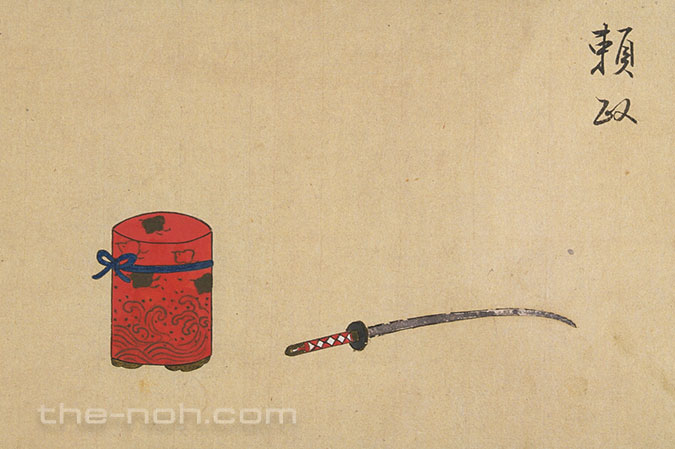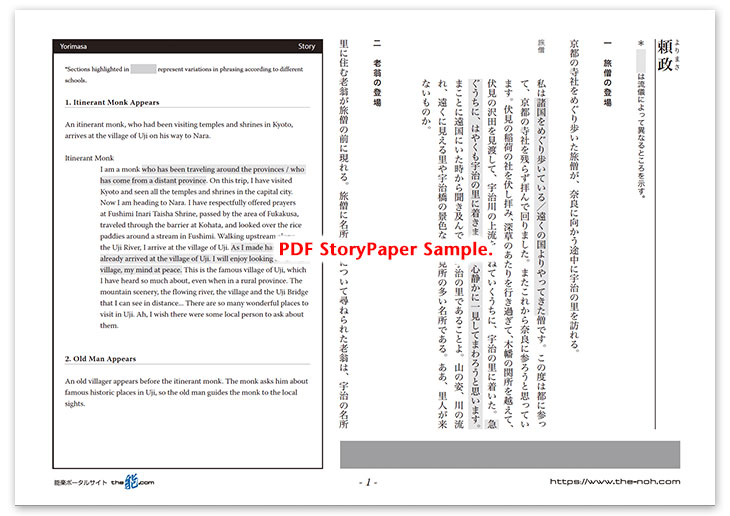
 Yorimasa
Yorimasa

![]()
An itinerant monk visits the village of Uji near Kyoto. An old man comes to talk to him, so he asks the old man to guide him to famous historic sites in the area. After visiting a few historic sites, the old man brings the monk to Byōdōin Temple. In the garden of the temple, there is a lawn grown in the shape of an opened folding fan. Wondering what it is, he asks the old man if there is a story behind the mysterious lawn. The old man explains that this is the very spot where Minamoto no Yorimasa, having been defeated in battle, committed suicide on his opened folding fan. This lawn is therefore called, “The Lawn of the Folding Fan” (Ougi no Shiba). When the monk offers prayers for the soul of Yorimasa, the old man tells him that this day is indeed the anniversary of Yorimasa’s death and, after revealing that he is the ghost of Yorimasa, vanishes into thin air.
Hearing, from a villager, why Yorimasa raised an army and how he faced his last moments, the itinerant monk once again prays for Yorimasa’s soul. He then takes a nap at the site, hoping to see Yorimasa in a dream. Then, the ghost of Yorimasa appears dressed as a monk but wearing armor, lamenting the transient nature of this world. He requests that the monk recite scripture from a sutra and narrates the story of how he raised his army and fled to Byōdōin Temple, as well as the fierce battle over the Uji River. He goes on to recount his final moments of composing a death poem before committing suicide. After asking the monk to console his soul, the ghost of Yorimasa disappears into the Lawn of the Folding Fan, just as though he were returning to the place of his final moments.
![]()
The lead character of this play is the warrior Minamoto no Yorimasa (1104-80), a well-respected poet who was also known as a master archer. This play, together with Sanemori and Tomonaga, are collectively called the San-Shura (“The Three Asuras,” that is, three Noh dramas themed around warriors who fell into the Asura Realm after their death). Yorimasa is valued for the advanced skills required to perform it. The original account of Yorimasa, recorded in the Tale of Heike, does not include the episode of the Lawn of the Folding Fan that features so prominently in this piece. Therefore, Zeami is believed to have incorporated the episode when he created this dramatic work.
The first half of the play contains poetic and elegant scenes describing historic sites in Uji, while in contrast the second half realistically depicts the scene of a battle. In the second half, although Yorimasa is shite (the lead character), he hardly stands up from a folding chair, presenting the audience with the very image of an old warrior as he commands his army and analyzes battle developments. The lead character skillfully expresses the fierce battle scenes with minimal movements of his body and a fan he holds. The special mask called “Yorimasa,” which the lead character wears in the second half, is used exclusively in this drama; its face expresses the regret and resentment of the old commander. Also exclusive to this play is the “Yorimasa hood” (Yorimasa zukin).
STORY PAPER : Yorimasa
Story Paper presents noh chant stories in modern speech, with story outlines, highlights and more using Adobe PDF format, which can print out and zoom in. Print out the pages and take them with you when you see the actual noh performance.

The copyright of Story Paper is held by the Noh.com. Story Paper is for individual use only. It is prohibited by the copyright law to distribute or publish printed-out Story Paper pages without prior consent. For more information, check the credit and disclaimer pages.



 [Yorimasa : Story Paper PDF : 534KB
[Yorimasa : Story Paper PDF : 534KB